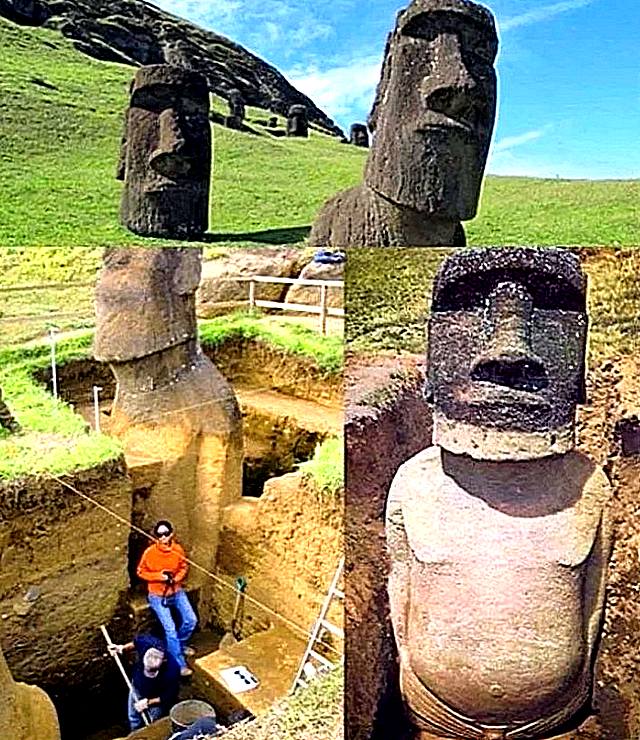So here's the deal, Easter Island statues bodies have been a mystery for centuries. These massive stone figures, known as moai, have fascinated people around the world with their enigmatic expressions and sheer size. But wait, there's more to the story than just the heads poking out of the ground. Beneath the surface lies a whole other world of secrets waiting to be uncovered. Are you ready to dive deep into the mysteries of Easter Island? Let's get started!
Imagine standing face to face with these ancient statues, feeling the weight of history pressing down on you. It's not just about the heads, folks. The bodies of the moai hold clues to the culture, beliefs, and engineering prowess of the Rapa Nui people who created them. This isn't your average archaeological site; it's a place where time stands still and the past whispers its secrets to those who listen closely enough.
As we journey through this article, we'll uncover the hidden stories behind the Easter Island statues bodies, explore the significance of these ancient monuments, and delve into the latest discoveries that continue to shape our understanding of this incredible place. So, buckle up and get ready for an adventure you won't forget!
Read also:Salad And Go Your Ultimate Healthy Eating Solution
Daftar Isi
- Introduction
- Biography of Easter Island
- The Discovery of Easter Island Statues Bodies
- How Were the Easter Island Statues Bodies Built?
- The Significance of the Easter Island Statues Bodies
- Unsolved Mysteries of the Easter Island Statues
- Recent Research and Discoveries
- Preserving the Easter Island Statues Bodies
- Easter Island Tourism and Its Impact
- Conclusion
Biography of Easter Island
The Enigmatic Rapa Nui People
Let's rewind a bit and talk about the creators of these incredible statues. The Rapa Nui people, the original inhabitants of Easter Island, have a rich and fascinating history. They settled on this remote island around 1200 AD and developed a unique culture that revolved around the construction of the moai. These statues weren't just random rocks carved into shapes; they were deeply connected to the Rapa Nui's spiritual and social lives.
Take a look at the table below for some quick facts about the Rapa Nui:
| Fact | Detail |
|---|---|
| Island Name | Rapa Nui |
| Settlement Date | Approximately 1200 AD |
| Population | Estimated 15,000 at peak |
| Language | Rapa Nui |
The Discovery of Easter Island Statues Bodies
For a long time, people only saw the heads of the moai sticking out of the ground, leading to the misconception that the statues were just giant heads. But in recent years, archaeologists have uncovered the truth. The bodies of the statues extend deep into the earth, some reaching up to 20 feet below the surface. It's like finding the missing pieces of a giant puzzle!
Archaeological digs have revealed intricate carvings and designs on the backs of the statues, adding layers of complexity to their stories. These discoveries have reshaped our understanding of the Easter Island statues bodies and the people who created them.
How Were the Easter Island Statues Bodies Built?
Engineering Marvels of the Past
Now, let's talk about how these massive statues were even built. The Rapa Nui people didn't have modern tools or machinery, yet they managed to carve, transport, and erect these colossal figures. It's mind-blowing, right? Here's a quick breakdown of the process:
- Carving: The statues were carved from volcanic rock found on the island.
- Transportation: They were moved using a combination of ropes, wooden sledges, and human power.
- Erection: Once at their final locations, the statues were carefully positioned upright, often on ceremonial platforms called ahu.
Each step of the process required incredible skill, teamwork, and ingenuity. The Rapa Nui people truly were masters of their craft!
Read also:Unveiling The Truth About Marie Temara Height
The Significance of the Easter Island Statues Bodies
The Easter Island statues bodies aren't just random carvings; they hold deep cultural and spiritual significance. For the Rapa Nui, the moai represented their ancestors and were believed to possess mana, a spiritual power that protected the community. The statues were placed facing inward, watching over the island and its people.
Additionally, the construction of the moai played a crucial role in maintaining social order. It required cooperation and collaboration among different groups, reinforcing the bonds within the community. The statues were more than just art; they were a testament to the unity and resilience of the Rapa Nui people.
Unsolved Mysteries of the Easter Island Statues
Even with all the discoveries made so far, there are still many unanswered questions about the Easter Island statues bodies. How exactly were they transported across the island? Why did the Rapa Nui stop building them? What caused the decline of their civilization?
These mysteries continue to intrigue researchers and visitors alike. Some theories suggest environmental factors, while others point to internal conflicts or external influences. The truth is probably a combination of all these factors, but we may never know for sure.
Recent Research and Discoveries
Thanks to advancements in technology and new archaeological methods, we're learning more about the Easter Island statues bodies every day. Recent digs have uncovered additional carvings and artifacts, providing valuable insights into the lives of the Rapa Nui people.
For example, researchers have found evidence of red pigment on some of the statues, suggesting they were painted in vibrant colors. This discovery adds a whole new dimension to our understanding of the moai and their role in Rapa Nui culture.
Preserving the Easter Island Statues Bodies
Preserving these ancient monuments is a top priority for archaeologists and conservationists. The harsh climate and environmental factors pose significant challenges to the longevity of the statues. Efforts are underway to protect them from erosion and damage, ensuring they can be appreciated by future generations.
Conservation projects involve careful cleaning, stabilization, and monitoring of the statues. Community involvement is also crucial, as the Rapa Nui people continue to play an active role in preserving their cultural heritage.
Easter Island Tourism and Its Impact
Tourism has brought both benefits and challenges to Easter Island. On one hand, it provides economic opportunities and raises awareness about the island's rich history. On the other hand, the influx of visitors can strain local resources and infrastructure.
Striking a balance between preserving the island's natural and cultural treasures and accommodating tourists is essential. Sustainable tourism practices, such as limiting visitor numbers and promoting eco-friendly activities, are being implemented to minimize the impact on the environment and local communities.
Conclusion
In conclusion, the Easter Island statues bodies are more than just impressive feats of engineering; they are a window into the past, revealing the stories and struggles of the Rapa Nui people. From their construction to their cultural significance, these statues continue to captivate and inspire those who encounter them.
So, what can you do? If you're planning a trip to Easter Island, make sure to respect the local culture and environment. Share this article with your friends and family to spread awareness about the importance of preserving these incredible monuments. Together, we can ensure that the secrets of the Easter Island statues bodies remain safe for generations to come.


